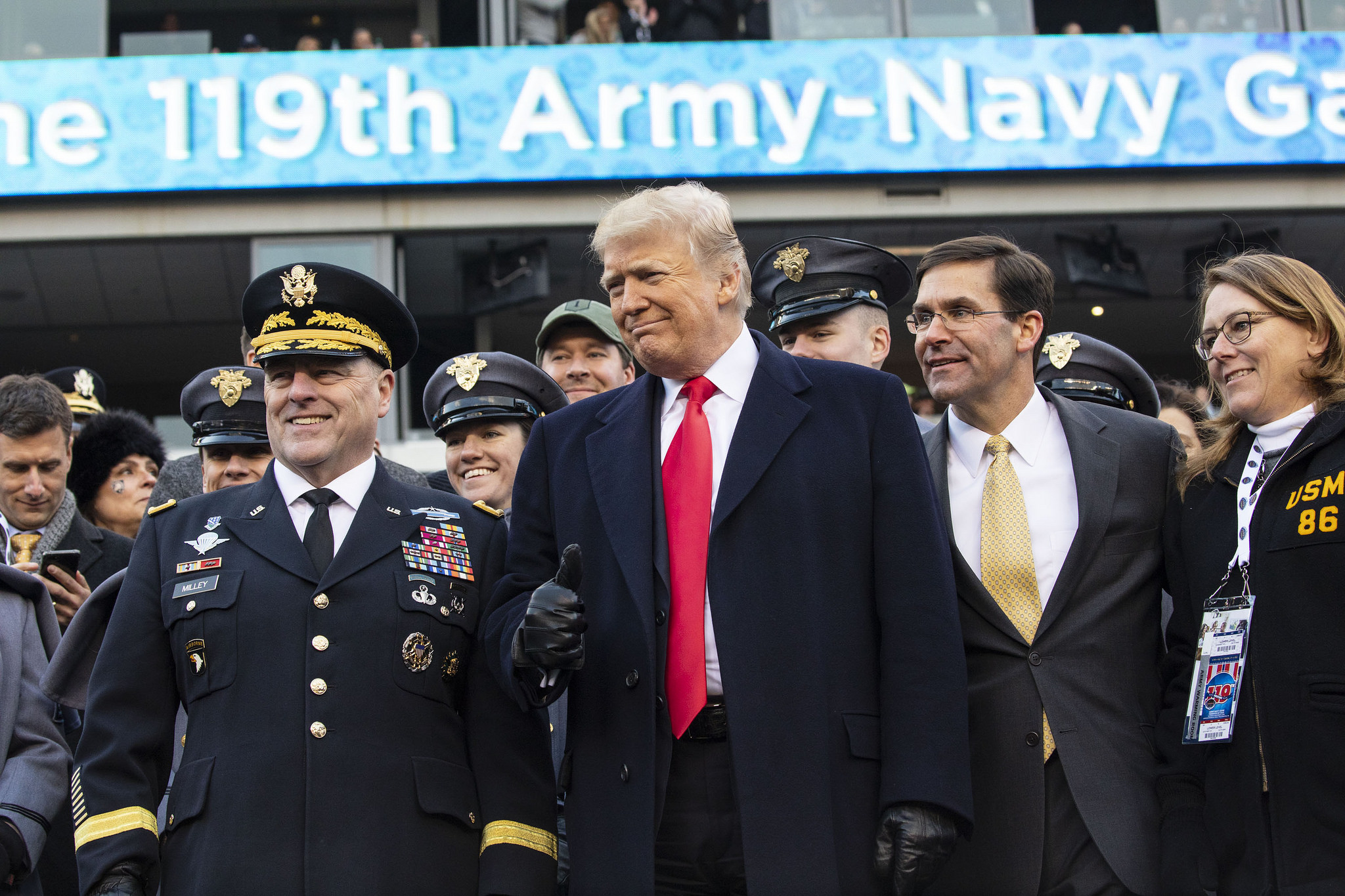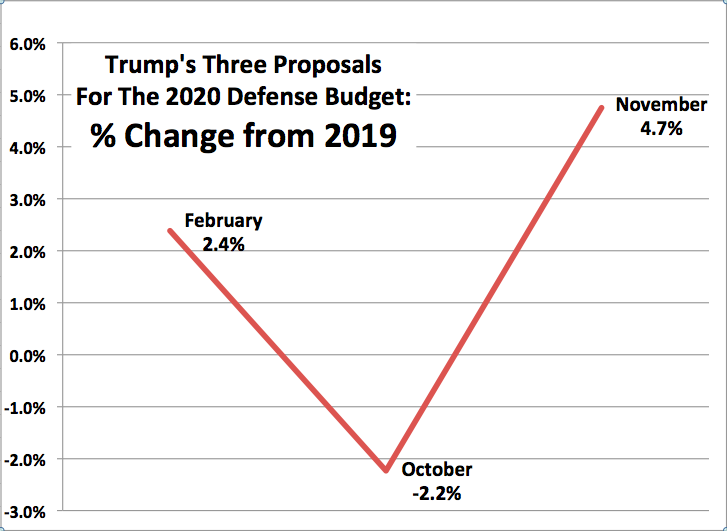$750 Billion Or Bust? Trump’s (Latest) Big Defense Budget Bound For Big Fights
Posted on
WASHINGTON: Whatever the national defense budget finally looks like for 2020 — and the Trump administration has now floated three wildly different toplines in less than three months — one thing is painfully clear: there will be a brutal fight to get any set of numbers through Congress.
Few of the experts we spoke to expect the administration to actually see the full $750 billion President Trump will reportedly propose this week. For starters, the figure is a staggering $100 billion above the 2020 budget cap under the Budget Control Act. Lawmakers have managed to broker bipartisan deals to lift the caps ever since sequestration hobbled the government in 2013, but it’s been hair-raising each time.
This time, moreover, dealmaking will require rounds of trade-offs between the Republican-controlled Senate and Democratically-controlled House. And it’ll be hard to sell $750 billion of defense to either Democrats or Republican budget hawks, not at a time of expanding national debt and five percent cuts to every other federal agency.
Assuming $73 billion of the total budget comes in the Overseas Contingency Operations (OCO) fund — meant to pay for the wars in Afghanistan, Syria, Iraq, and other troop deployments around the globe, but often used to exempt “base” defense spending from budget caps — the bill will force Democrats to answer questions about their support for the grinding Forever War that is staggering toward its 18th birthday. That’s a potential deal-breaker, especially for would-be presidential contenders aiming to court the Democratic base in primaries.
If those congressional Democrats insist on an equal increase in the non-defense spending cap, the total deal would increase spending by $202 billion — pushing the deficit above $1 trillion in 2020. “I think growing the deficit to $1.2 trillion will give a lot of people heartburn,” on both sides of the aisle, said Todd Harrison, the sharp-tongued budget guru at the Center for Strategic & International Studies.
Just to lengthen the odds further, Trump is cited in Politico as calling the $750 billion a “negotiating tactic,” an opening big to keep the Democrats from pushing the final negotiated level below $733 — which hardly implies a hard and fast commitment to the higher figure.
“Advertising your negotiating tactic before serious talks are underway on a budget deal undercuts the entire effort,” said MacKenzie Eaglen of the American Enterprise Institute.
“It also highlights the arbitrary nature of picking $750 out of thin air,” Eaglen said. (Though others argue the number isn’t that arbitrary — see below). “$733 billion is a ton of money, but at least it’s based on threats and requirements,” she said. “$750B is just rounding up and will be easily dismissed by those who write the bills and sign the checks.”
While a bonda fide defense hawk who started her ascent at Heritage, Eaglen is the voice of conservatives who’re getting burned out by Trump’s decisions and revisions which a minute will reverse. She’s been predicting that Trump’s promised defense increase will not materialize — and as early as January 2017, she warned that Trump was far more likely to boost the deficit than defense.
By The Numbers
An announcement is expected this week that President Trump has decided to ask Congress for $750 billion for fiscal 2020, a massive increase from the $716 billion allocated to defense in 2019, which Trump just last week referred to as “Crazy!” And it comes a little over a month since the White House to ordered the Pentagon to forget the $733 billion request it had planned and submit a $700 billion budget in 2020 instead.
While both $700 and $750 billion are suspiciously nice, round numbers, the latest figure does line up with the kind of growth the Pentagon has been asking for consistently. Starting from 2019’s $716 billion budget, it adds 2 percent for inflation plus 2.7 percent growth. That comes close to the “at least three percent over inflation” increases that the military needs “to arrest…the erosion of our competitive advantage,” Joint Chiefs chairman Gen. Joseph Dunford has testified. “Restoring it would cost more.”
Nevertheless, with Trump reversing his earlier reversal, we’re seeing fiscal whiplash inside the beltway. Staffers at the Pentagon and other national security agencies confused as to what numbers the president might finally order cooked up when budgets are sent to Congress in February. Before lawmakers can start debating those numbers however, the Pentagon first needs to find parking spots for the additional $17 billion to make all of the budget lines equal $750 billion.
“I would expect it would just sprinkle the money around and add a little more of everything,” said CSIS’s Harrison. “Bureaucratically, it’s easy to plus things up at the last minute without much strategic thought, and I’m sure the services all have their unfunded priority lists waiting and ready to go.”
The Pentagon is hardly starting from scratch here, however. Pentagon budget crunchers have already completed work on their original $733 billion request, so they’re likely still sitting on “lots of proposals for spending more money,” observed Mark Cancian, a senior adviser with the CSIS International Security Program. He expects money to flow into new modernization programs and pushing some programs into production, particularly those focused on competition with China and Russia, both of whom loomed large in the National Defense Strategy released earlier this year.
Former Pentagon Chief Financial Officer Bob Hale agreed that it will be relatively easy for the services to submit their existing unfunded request lists up the chain in hopes to secure some of the $17 billion, and he expects to see increases in R&D and procurement, “given the Administration’s emphasis on modernization — though all parts of the budget will probably benefit to some extent.”
Which service stands to benefit most is an open question. The Navy, perhaps more than the other services, is simultaneously struggling to repair readiness and procure big new weapons, including buying two aircraft carriers simultaneously and moving ahead on its Columbia-class nuclear missile submarine. Navy Secretary Richard Spencer has probably been the most vocal critic of budget cuts, publicly begging the administration that “the bicycle is up, we are pedaling; please don’t knock us over.”
Travis Sharp of the Center for Strategic and Budgetary Assessments says the larger $750 billion budget also presents a problem for crafting, and sticking with, a sound and sustainable defense strategy. “When funding increases, DoD can avoid making some hard choices about priorities,” he said. “Everybody wins, even if some win more than others. That makes it hard to discern whether DoD is truly committed to the strategy.”
For now, we’re still trying to figure out if the President is truly committed to any number.
Subscribe to our newsletter
Promotions, new products and sales. Directly to your inbox.







